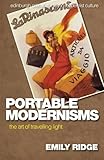Portable Modernisms : The Art of Travelling Light / Emily Ridge.
Material type: TextSeries: Edinburgh Critical Studies in Modernist Culture : ECCSMCPublisher: Edinburgh : Edinburgh University Press, [2022]Copyright date: ©2017Description: 1 online resource (224 p.) : 10 B/W illustrationsContent type:
TextSeries: Edinburgh Critical Studies in Modernist Culture : ECCSMCPublisher: Edinburgh : Edinburgh University Press, [2022]Copyright date: ©2017Description: 1 online resource (224 p.) : 10 B/W illustrationsContent type: - 9781474419598
- 9781474419604
- 809.304 23
- online - DeGruyter
| Item type | Current library | Call number | URL | Status | Notes | Barcode | |
|---|---|---|---|---|---|---|---|
 eBook
eBook
|
Biblioteca "Angelicum" Pont. Univ. S.Tommaso d'Aquino Nuvola online | online - DeGruyter (Browse shelf(Opens below)) | Online access | Not for loan (Accesso limitato) | Accesso per gli utenti autorizzati / Access for authorized users | (dgr)9781474419604 |
Frontmatter -- CONTENTS -- Illustrations -- Acknowledgements -- Series Editors’ Preface -- Introduction -- 1 ‘Living modernly’s living quickly’: Towards Travelling Light -- 2 ‘A purse of her own’: Women and Carriage -- 3 ‘No one is safe from the beggar’s pack’: Portability and Precarity -- 4 ‘Have you anything to declare?’: Portable Selves on Trial -- Conclusion -- Bibliography -- Index
restricted access online access with authorization star
http://purl.org/coar/access_right/c_16ec
A wide-ranging study of the rise of a new culture of portability and its impact on modernist approaches to fictionLuggage is an overlooked detail in the stock sketch of the expatriated modernist writer from the valise-fashioned desks of both James Joyce and Vladimir Nabokov to the lost manuscript-laden cases of Ernest Hemingway and Walter Benjamin. While the trope of modernist exile has long been spotlighted, little attention has been given to the material meaning of this condition. What things and objects do modernism’s exiles and émigrés carry with them and how does the act of carriage enter into the modernist picture more broadly? What are the implications and historical resonances of a portable outlook, particularly from the angles of gender, wartime conflict and character conception? Above all, how far does such an outlook impact upon artistic vision? Portability represents the simultaneous transportation and repudiation of domesticity and the home, those key frames of reference in the nineteenth-century novel. This book examines the multifarious ways in which the emergence of a modern culture of portability prompts a radical, if often problematic, departure from Victorian architectural conceptions of fiction towards more movable understandings of form and character.Key FeaturesPresents the first full-length formulation of portable models for fiction and, as such, opens up a new field of enquirySheds fresh light on our understanding of the history of the novel through one long-obscured metaphor for narrative formConstructively integrates recent discussions of material culture and mobility in modernism within a single monograph and links these discussions to more formal questionsIncludes archival research on the material culture of movement and travel during the period
Mode of access: Internet via World Wide Web.
In English.
Description based on online resource; title from PDF title page (publisher's Web site, viewed 29. Jun 2022)


